Home / A Fourth Alkene Addition Pattern – Free Radical Addition
Alkene Reactions
A Fourth Alkene Addition Pattern – Free Radical Addition
Last updated: March 21st, 2025 |
Free Radical Addition Of HBr To Alkenes With ROOR (Peroxides)
We’ve seen that there are three major alkene reactivity patterns [carbocation, three membered ring, and concerted], but there are two minor pathways as well. This post discusses one of them: free-radical addition of HBr to alkenes, which shows the opposite regioselectivity (anti-Markovnikov) than “normal” addition of HBr to alkenes (Markovnikov) which follows the “carbocation” pathway.
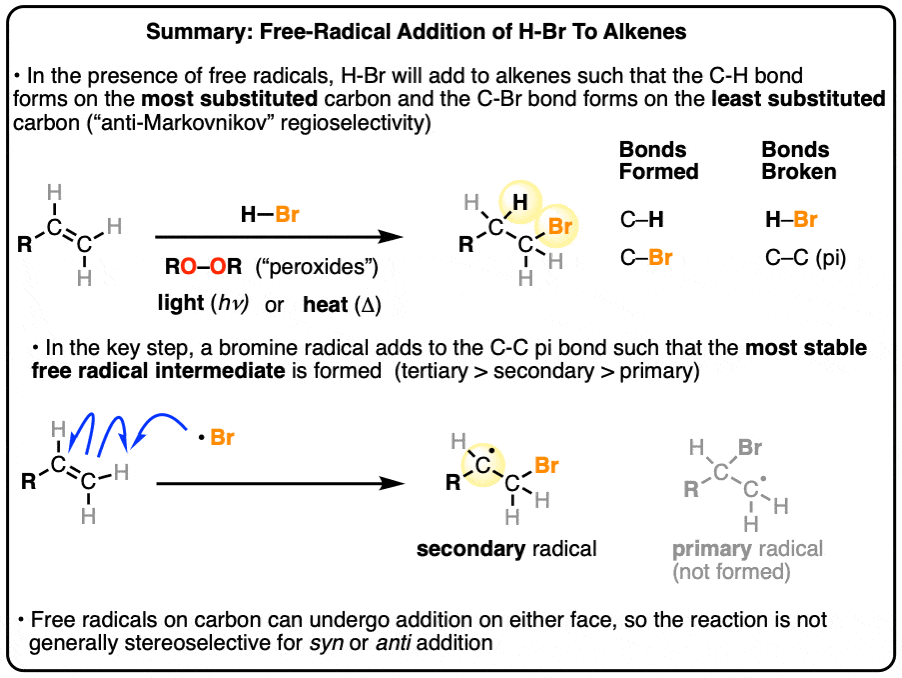
Table of Contents
- Free Radical Addition Of HBr To Alkenes Leads To “Anti-Markovnikov” Products
- An Outline Of The Free Radical Mechanism For Addition Of HBr To Alkenes In The Presence Of Peroxides
- Initiation Of The Free-Radical Process Through Homolytic Cleavage Of Peroxides By Heat Or Light
- Formation Of The Bromine Radical From The Alkoxide Radical And HBr
- Propagation Step #1 : Addition Of Bromine Radical To The Alkene Occurs So As To Give The Most Stable Carbon Radical
- Propagation Step #2: The Resulting Carbon Radical Removes A Hydrogen Atom From H–Br, Regenerating The Bromine Radical
- The Termination Step
- Summary: Free-Radical Addition Of HBr To Alkenes
- Notes
- Quiz Yourself!
- (Advanced) References and Further Reading
1. Free Radical Addition Of HBr To Alkenes Leads To “Anti-Markovnikov” Products
As discussed previously, alkenes normally react with HBr to give products of “Markovnikov” addition; the bromine ends up on the most substituted carbon of the alkene, and the hydrogen ends up on the least substituted carbon. However, something interesting happens when the same reaction is performed in the presence of peroxides and heat / light: the pattern of addition changes!
Instead of Br ending up on the most substituted carbon of the alkene, it ends up on the least. [The stereochemistry of the reaction, however, is unchanged: it still gives a mixture of “syn” and “anti” products.]
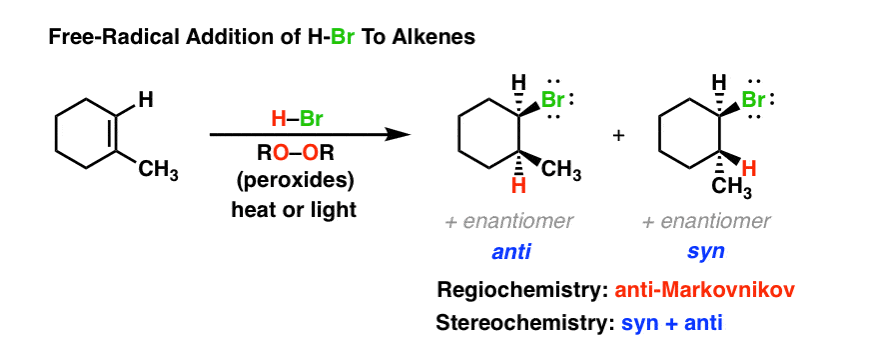
This so-called “anti-Markovnikov” addition is intriguing. What difference could the presence of peroxides, and furthermore heat (or light) make to this reaction?
2. An Outline Of The Free Radical Mechanism For Addition Of HBr To Alkenes In The Presence Of ROOR (Peroxides)
This reaction occurs through a free-radical process. (For a primer on free radical chemistry, you might want to check out this introductory article on Free Radical Reactions). Here is an outline of the mechanism:
- Peroxides contain a weak oxygen-oxygen bond [approximately 35 kcal/mol; compare to C-H at approx 100 kcal/mol]
- Heating leads to homolytic fragmentation of this bond – that is, the bond breaks such as to leave one unpaired electron on each atom. Strong sources of light [e.g. a floodlight or other source of light radiation which reaches into the near UV] can also serve to sever this bond.
- The resulting highly reactive alkoxy radical can then abstract a hydrogen from H-Br, giving a bromine radical. The bromine radical is the species that adds to the alkene.
- Addition to the alkene will preferably occur in such a way that the most stable free radical is formed [in the case above, the tertiary radical]. That’s why bromine ends up on the least substituted carbon of the alkene. (See: 3 Factors Which Stabilize Free Radicals)
- This tertiary radical then removes hydrogen from H-Br, liberating a bromine radical, and the cycle continues.
3. Initiation Of The Free-Radical Process Through Homolytic Cleavage Of ROOR (Peroxides) By Heat Or Light
Only a trace [catalytic] amount of peroxide is required to get the reaction started, although of course at least one molar equivalent of HBr is required to result in full addition of HBr to the alkene.
In the first step, addition of energy (in the form of heat or light) leads to homolytic fragmentation of the weak O–O bond to generate two new free radicals. “Homolytic” means that the bond is broken such that each atom receives the same (“homos” = Greek for “same”) number of electrons.
(Most of the bond breakage we see in organic chemistry is heterolytic, where the bond breaks unequally. )

The singly barbed arrows depict the movement of single electrons; two alkoxy radicals are formed. Since there is a net increase in the number of radicals (0 →2) this is an initiation step.
Common “peroxides” for this purpose are t-butyl peroxide or benzoyl peroxide. [Note 1]. Alternatively other free-radical “initiators” such as AIBN can also be used.
Only a catalytic amount of peroxides are used to initate this reaction (typically 10-20 mole %, although more can be used, especially when added batchwise).
4. Formation Of The Bromine Radical From The Alkoxide Radical And HBr
In the next step, one of the oxygen radicals from step 1 removes a hydrogen from H–Br in another homolytic process.

Here, we’re forming an H–O bond (bond dissociation energy of 102 kcal/mol for H–O in CH3OH) and breaking an H–Br bond (bond dissociation energy of 87 kcal/mol) , so a difference in energy of about 15 kcal/mol makes this process essentially irreversible.
(Note: since this process does not change the number of free radicals, it is technically a propagation step)
5. Propagation Step #1 : Addition Of Bromine Radical To The Alkene Occurs So As To Give The Most Stable Carbon Radical
Once formed, the bromine radical can then add to the alkene.
In a relatively “flat” alkene such as 1-methylcyclohexene, addition of the radical will occur with equal probability from either face.
The question is, which atom of the double bond does the free radical attack? The bond could break two different ways, after all.
- Attack of the bromine radical on the more substituted carbon would result in a new free radical on a secondary carbon.
- Attack of the bromine radical on the less substituted carbon would result in a new free radical on a tertiary carbon.
Free radicals are electron-deficient species and are stabilized by adjacent electron donors. The more stable free radical intermediate is the tertiary free radical, and that is why addition occurs predominantly at the less substituted carbon (i.e. the carbon attached to the fewest number of carbons).
This explains the “anti-Markovnikov” selectivity of the reaction.

6. Propagation Step #2: The Resulting Carbon Radical Removes A Hydrogen Atom From H–Br, Regenerating The Bromine Radical
In a second propagation step in the main sequence, the resulting carbon radical removes a hydrogen from another equivalent of H–Br, giving the final addition product.
Alkyl free radicals are sp2-hybridized, and are shallow pyramids that invert easily.
H–Br, therefore, can react on either face of the free radical [Note 2]. If it attacks on the same face as the Br, then we obtain a “syn” product. If it attacks on the opposite face of the Br, then the product is “anti“.
A mixture of both will be obtained. The reaction is not stereoselective.
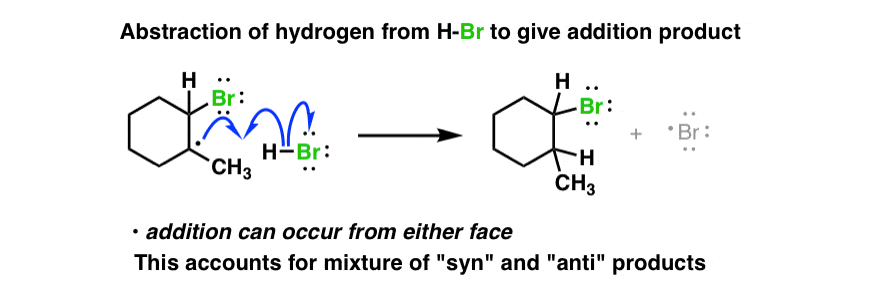
A bromine radical is generated by this process, which can then add to another equivalent of alkene (propagation step #1).
7. The Termination Step
When the concentration of HBr and alkene become low relative to the concentration of free radical, termination can occur (See post: Initiation, Propagation, Termination). This could occur through a variety of specific pathways (not shown) involving recombination of two free radicals to generate a new bond.
8. Summary: Free-Radical Addition Of HBr To Alkenes
This reaction pathway is most commonly observed (in Org 1 and Org 2, anyway) for addition of HBr, although a rich chemistry of radical addition reactions to alkenes exists (particularly for organostannanes).
NEXT POST: Ozonolysis of Alkenes
Notes
Related Articles
- Alkene Reactions: Ozonolysis
- Initiation, Propagation, Termination
- Free Radical Initiation: Why Is “Light” Or “Heat” Required?
- Alkene Addition Pattern #2: The “Three-Membered Ring” Pathway
- Addition Pattern #1: The “Carbocation Pathway”
- Alkene Addition Pattern #3: The “Concerted” Pathway
- 3 Factors That Stabilize Free Radicals
- Alkene Hydrohalogenation Mechanism And How It Explains Markovnikov’s Rule
- Free Radicals Practice Quizzes
- Alkene Reactions Practice Problems (MOC Membership)
- Alkene Addition Reactions: “Regioselectivity” and “Stereoselectivity” (Syn/Anti)
- Stereoselective and Stereospecific Reactions
Note 1. Benzoyl peroxide enjoys a common household use as an acne cleanser, and even makes an appearance in this classic ad for Oxy skin care (“Oxycute ‘Em”.)
Note 2. The geometry of free radical carbons is that of a shallow pyramid with a low barrier for inversion, allowing for reactivity on either face. The exception is in weird cases where inversion would be highly disfavored, such as on a bridgehead (See Bicyclic Molecules and How To Name Them).
Quiz Yourself!
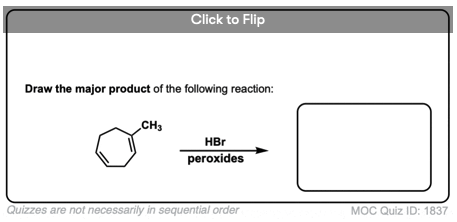
Become a MOC member to see the clickable quiz with answers on the back.
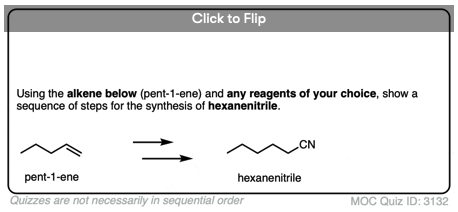
Become a MOC member to see the clickable quiz with answers on the back.
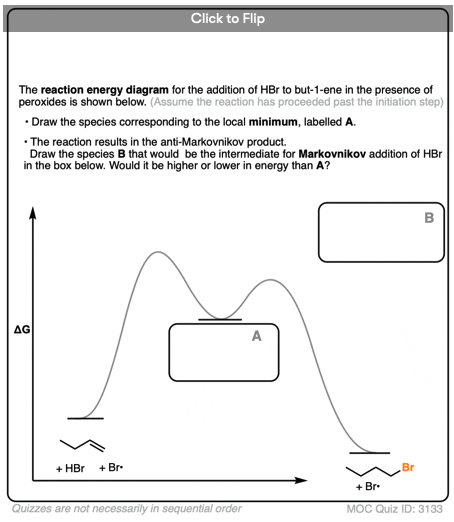
Become a MOC member to see the clickable quiz with answers on the back.
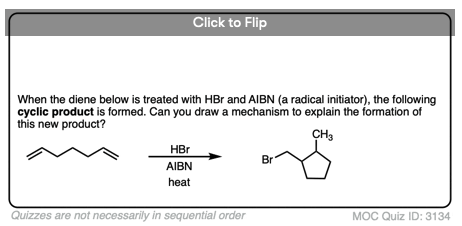
Become a MOC member to see the clickable quiz with answers on the back.
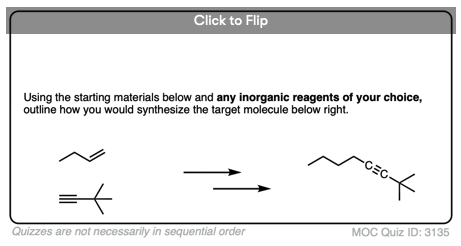
Become a MOC member to see the clickable quiz with answers on the back.
(Advanced) References and Further Reading
Bond Dissociation Energies From Lowry & Richardson, “Mechanism and Theory In Organic Chemistry“, Harper & Row, 1987 pp 161-162
- The Peroxide Effect in the Addition of Reagents to Unsaturated Compounds and in Rearrangement Reactions.
Frank R. Mayo and Cheves Walling
Chemical Reviews 1940, 27 (2), 351-412
DOI: 10.1021/cr60087a003
F. R. Mayo was a student of the prominent chemist M. S. Kharasch, and together they first described the “peroxide effect” in the anti-Markovnikov addition of HBr to alkenes, ascribing it to a free-radical mechanism. - ADDITION OF HYDROGEN BROMIDE TO 4,4-DIMETHYLPENTENE-1
M. S. Kharasch, Chester Hannum, and M. Gladstone
Journal of the American Chemical Society 1934, 56 (1), 244-244
DOI: 10.1021/ja01316a504
This communication describes both products that are obtained from HBr addition to the title olefin via the electrophilic and radical mechanisms. - THE PHOTO-ADDITION OF HYDROGEN BROMIDE TO OLEFINIC BONDS
WILLIAM E. VAUGHAN, FREDERICK F. RUST, and THEODORE W. EVANS
The Journal of Organic Chemistry 1942, 07 (6), 477-490
DOI: 10.1021/jo01200a005
The radical addition of HBr can be initiated not just by peroxides, but also by light, as this paper describes. - The Peroxide Effect in the Addition of Reagents to Unsaturated Substances. XXII. The Addition of Hydrogen Bromide to Trimethylethylene, Styrene, Crotonic Acid, and Ethyl Crotonate
Cheves Walling, M. S. Kharasch, and F. R. Mayo
Journal of the American Chemical Society 1939, 61 (10), 2693-2696
DOI: 10.1021/ja01265a034
Kharasch and co-workers reported the hydrobromination of styrene in dilute pentane solution with dibenzoyl peroxide to give an 80 : 20 ratio in favor of the primary bromide. Unfortunately, detailed conditions were not provided. - Scalable anti-Markovnikov hydrobromination of aliphatic and aromatic olefins
Marzia Galli, Catherine J. Fletcher, Marc del Pozo, and Stephen M. Goldup
Org. Biomol. Chem., 2016, 14, 5622-5626
DOI: 10.1039/C6OB00692B
This is an interesting paper demonstrating the relevance of this chemistry in modern organic synthesis; it describes the rediscovery of simple scalable conditions for synthesis of primary bromides under “initiator free” conditions from alkyl and aryl alkenes.
00 General Chemistry Review
01 Bonding, Structure, and Resonance
- How Do We Know Methane (CH4) Is Tetrahedral?
- Hybrid Orbitals and Hybridization
- How To Determine Hybridization: A Shortcut
- Orbital Hybridization And Bond Strengths
- Sigma bonds come in six varieties: Pi bonds come in one
- A Key Skill: How to Calculate Formal Charge
- The Four Intermolecular Forces and How They Affect Boiling Points
- 3 Trends That Affect Boiling Points
- How To Use Electronegativity To Determine Electron Density (and why NOT to trust formal charge)
- Introduction to Resonance
- How To Use Curved Arrows To Interchange Resonance Forms
- Evaluating Resonance Forms (1) - The Rule of Least Charges
- How To Find The Best Resonance Structure By Applying Electronegativity
- Evaluating Resonance Structures With Negative Charges
- Evaluating Resonance Structures With Positive Charge
- Exploring Resonance: Pi-Donation
- Exploring Resonance: Pi-acceptors
- In Summary: Evaluating Resonance Structures
- Drawing Resonance Structures: 3 Common Mistakes To Avoid
- How to apply electronegativity and resonance to understand reactivity
- Bond Hybridization Practice
- Structure and Bonding Practice Quizzes
- Resonance Structures Practice
02 Acid Base Reactions
- Introduction to Acid-Base Reactions
- Acid Base Reactions In Organic Chemistry
- The Stronger The Acid, The Weaker The Conjugate Base
- Walkthrough of Acid-Base Reactions (3) - Acidity Trends
- Five Key Factors That Influence Acidity
- Acid-Base Reactions: Introducing Ka and pKa
- How to Use a pKa Table
- The pKa Table Is Your Friend
- A Handy Rule of Thumb for Acid-Base Reactions
- Acid Base Reactions Are Fast
- pKa Values Span 60 Orders Of Magnitude
- How Protonation and Deprotonation Affect Reactivity
- Acid Base Practice Problems
03 Alkanes and Nomenclature
- Meet the (Most Important) Functional Groups
- Condensed Formulas: Deciphering What the Brackets Mean
- Hidden Hydrogens, Hidden Lone Pairs, Hidden Counterions
- Don't Be Futyl, Learn The Butyls
- Primary, Secondary, Tertiary, Quaternary In Organic Chemistry
- Branching, and Its Affect On Melting and Boiling Points
- The Many, Many Ways of Drawing Butane
- Wedge And Dash Convention For Tetrahedral Carbon
- Common Mistakes in Organic Chemistry: Pentavalent Carbon
- Table of Functional Group Priorities for Nomenclature
- Summary Sheet - Alkane Nomenclature
- Organic Chemistry IUPAC Nomenclature Demystified With A Simple Puzzle Piece Approach
- Boiling Point Quizzes
- Organic Chemistry Nomenclature Quizzes
04 Conformations and Cycloalkanes
- Staggered vs Eclipsed Conformations of Ethane
- Conformational Isomers of Propane
- Newman Projection of Butane (and Gauche Conformation)
- Introduction to Cycloalkanes
- Geometric Isomers In Small Rings: Cis And Trans Cycloalkanes
- Calculation of Ring Strain In Cycloalkanes
- Cycloalkanes - Ring Strain In Cyclopropane And Cyclobutane
- Cyclohexane Conformations
- Cyclohexane Chair Conformation: An Aerial Tour
- How To Draw The Cyclohexane Chair Conformation
- The Cyclohexane Chair Flip
- The Cyclohexane Chair Flip - Energy Diagram
- Substituted Cyclohexanes - Axial vs Equatorial
- Ranking The Bulkiness Of Substituents On Cyclohexanes: "A-Values"
- Cyclohexane Chair Conformation Stability: Which One Is Lower Energy?
- Fused Rings - Cis-Decalin and Trans-Decalin
- Naming Bicyclic Compounds - Fused, Bridged, and Spiro
- Bredt's Rule (And Summary of Cycloalkanes)
- Newman Projection Practice
- Cycloalkanes Practice Problems
05 A Primer On Organic Reactions
- The Most Important Question To Ask When Learning a New Reaction
- Curved Arrows (for reactions)
- Nucleophiles and Electrophiles
- The Three Classes of Nucleophiles
- Nucleophilicity vs. Basicity
- What Makes A Good Nucleophile?
- What Makes A Good Leaving Group?
- 3 Factors That Stabilize Carbocations
- Equilibrium and Energy Relationships
- 7 Factors that stabilize negative charge in organic chemistry
- 7 Factors That Stabilize Positive Charge in Organic Chemistry
- What's a Transition State?
- Hammond's Postulate
- Learning Organic Chemistry Reactions: A Checklist (PDF)
- Introduction to Oxidative Cleavage Reactions
06 Free Radical Reactions
- Bond Dissociation Energies = Homolytic Cleavage
- Free Radical Reactions
- 3 Factors That Stabilize Free Radicals
- What Factors Destabilize Free Radicals?
- Bond Strengths And Radical Stability
- Free Radical Initiation: Why Is "Light" Or "Heat" Required?
- Initiation, Propagation, Termination
- Monochlorination Products Of Propane, Pentane, And Other Alkanes
- Selectivity In Free Radical Reactions
- Selectivity in Free Radical Reactions: Bromination vs. Chlorination
- Halogenation At Tiffany's
- Allylic Bromination
- Bonus Topic: Allylic Rearrangements
- In Summary: Free Radicals
- Synthesis (2) - Reactions of Alkanes
- Free Radicals Practice Quizzes
07 Stereochemistry and Chirality
- Types of Isomers: Constitutional Isomers, Stereoisomers, Enantiomers, and Diastereomers
- How To Draw The Enantiomer Of A Chiral Molecule
- How To Draw A Bond Rotation
- Introduction to Assigning (R) and (S): The Cahn-Ingold-Prelog Rules
- Assigning Cahn-Ingold-Prelog (CIP) Priorities (2) - The Method of Dots
- Enantiomers vs Diastereomers vs The Same? Two Methods For Solving Problems
- Assigning R/S To Newman Projections (And Converting Newman To Line Diagrams)
- How To Determine R and S Configurations On A Fischer Projection
- The Meso Trap
- Optical Rotation, Optical Activity, and Specific Rotation
- Optical Purity and Enantiomeric Excess
- What's a Racemic Mixture?
- Chiral Allenes And Chiral Axes
- Stereochemistry Practice Problems and Quizzes
08 Substitution Reactions
- Nucleophilic Substitution Reactions - Introduction
- Two Types of Nucleophilic Substitution Reactions
- The SN2 Mechanism
- Why the SN2 Reaction Is Powerful
- The SN1 Mechanism
- The Conjugate Acid Is A Better Leaving Group
- Comparing the SN1 and SN2 Reactions
- Polar Protic? Polar Aprotic? Nonpolar? All About Solvents
- Steric Hindrance is Like a Fat Goalie
- Common Blind Spot: Intramolecular Reactions
- Substitution Practice - SN1
- Substitution Practice - SN2
09 Elimination Reactions
- Elimination Reactions (1): Introduction And The Key Pattern
- Elimination Reactions (2): The Zaitsev Rule
- Elimination Reactions Are Favored By Heat
- Two Elimination Reaction Patterns
- The E1 Reaction
- The E2 Mechanism
- E1 vs E2: Comparing the E1 and E2 Reactions
- Antiperiplanar Relationships: The E2 Reaction and Cyclohexane Rings
- Bulky Bases in Elimination Reactions
- Comparing the E1 vs SN1 Reactions
- Elimination (E1) Reactions With Rearrangements
- E1cB - Elimination (Unimolecular) Conjugate Base
- Elimination (E1) Practice Problems And Solutions
- Elimination (E2) Practice Problems and Solutions
10 Rearrangements
11 SN1/SN2/E1/E2 Decision
- Identifying Where Substitution and Elimination Reactions Happen
- Deciding SN1/SN2/E1/E2 (1) - The Substrate
- Deciding SN1/SN2/E1/E2 (2) - The Nucleophile/Base
- SN1 vs E1 and SN2 vs E2 : The Temperature
- Deciding SN1/SN2/E1/E2 - The Solvent
- Wrapup: The Key Factors For Determining SN1/SN2/E1/E2
- Alkyl Halide Reaction Map And Summary
- SN1 SN2 E1 E2 Practice Problems
12 Alkene Reactions
- E and Z Notation For Alkenes (+ Cis/Trans)
- Alkene Stability
- Alkene Addition Reactions: "Regioselectivity" and "Stereoselectivity" (Syn/Anti)
- Stereoselective and Stereospecific Reactions
- Hydrohalogenation of Alkenes and Markovnikov's Rule
- Hydration of Alkenes With Aqueous Acid
- Rearrangements in Alkene Addition Reactions
- Halogenation of Alkenes and Halohydrin Formation
- Oxymercuration Demercuration of Alkenes
- Hydroboration Oxidation of Alkenes
- m-CPBA (meta-chloroperoxybenzoic acid)
- OsO4 (Osmium Tetroxide) for Dihydroxylation of Alkenes
- Palladium on Carbon (Pd/C) for Catalytic Hydrogenation of Alkenes
- Cyclopropanation of Alkenes
- A Fourth Alkene Addition Pattern - Free Radical Addition
- Alkene Reactions: Ozonolysis
- Summary: Three Key Families Of Alkene Reaction Mechanisms
- Synthesis (4) - Alkene Reaction Map, Including Alkyl Halide Reactions
- Alkene Reactions Practice Problems
13 Alkyne Reactions
- Acetylides from Alkynes, And Substitution Reactions of Acetylides
- Partial Reduction of Alkynes With Lindlar's Catalyst
- Partial Reduction of Alkynes With Na/NH3 To Obtain Trans Alkenes
- Alkyne Hydroboration With "R2BH"
- Hydration and Oxymercuration of Alkynes
- Hydrohalogenation of Alkynes
- Alkyne Halogenation: Bromination, Chlorination, and Iodination of Alkynes
- Alkyne Reactions - The "Concerted" Pathway
- Alkenes To Alkynes Via Halogenation And Elimination Reactions
- Alkynes Are A Blank Canvas
- Synthesis (5) - Reactions of Alkynes
- Alkyne Reactions Practice Problems With Answers
14 Alcohols, Epoxides and Ethers
- Alcohols - Nomenclature and Properties
- Alcohols Can Act As Acids Or Bases (And Why It Matters)
- Alcohols - Acidity and Basicity
- The Williamson Ether Synthesis
- Ethers From Alkenes, Tertiary Alkyl Halides and Alkoxymercuration
- Alcohols To Ethers via Acid Catalysis
- Cleavage Of Ethers With Acid
- Epoxides - The Outlier Of The Ether Family
- Opening of Epoxides With Acid
- Epoxide Ring Opening With Base
- Making Alkyl Halides From Alcohols
- Tosylates And Mesylates
- PBr3 and SOCl2
- Elimination Reactions of Alcohols
- Elimination of Alcohols To Alkenes With POCl3
- Alcohol Oxidation: "Strong" and "Weak" Oxidants
- Demystifying The Mechanisms of Alcohol Oxidations
- Protecting Groups For Alcohols
- Thiols And Thioethers
- Calculating the oxidation state of a carbon
- Oxidation and Reduction in Organic Chemistry
- Oxidation Ladders
- SOCl2 Mechanism For Alcohols To Alkyl Halides: SN2 versus SNi
- Alcohol Reactions Roadmap (PDF)
- Alcohol Reaction Practice Problems
- Epoxide Reaction Quizzes
- Oxidation and Reduction Practice Quizzes
15 Organometallics
- What's An Organometallic?
- Formation of Grignard and Organolithium Reagents
- Organometallics Are Strong Bases
- Reactions of Grignard Reagents
- Protecting Groups In Grignard Reactions
- Synthesis Problems Involving Grignard Reagents
- Grignard Reactions And Synthesis (2)
- Organocuprates (Gilman Reagents): How They're Made
- Gilman Reagents (Organocuprates): What They're Used For
- The Heck, Suzuki, and Olefin Metathesis Reactions (And Why They Don't Belong In Most Introductory Organic Chemistry Courses)
- Reaction Map: Reactions of Organometallics
- Grignard Practice Problems
16 Spectroscopy
- Degrees of Unsaturation (or IHD, Index of Hydrogen Deficiency)
- Conjugation And Color (+ How Bleach Works)
- Introduction To UV-Vis Spectroscopy
- UV-Vis Spectroscopy: Absorbance of Carbonyls
- UV-Vis Spectroscopy: Practice Questions
- Bond Vibrations, Infrared Spectroscopy, and the "Ball and Spring" Model
- Infrared Spectroscopy: A Quick Primer On Interpreting Spectra
- IR Spectroscopy: 4 Practice Problems
- 1H NMR: How Many Signals?
- Homotopic, Enantiotopic, Diastereotopic
- Diastereotopic Protons in 1H NMR Spectroscopy: Examples
- 13-C NMR - How Many Signals
- Liquid Gold: Pheromones In Doe Urine
- Natural Product Isolation (1) - Extraction
- Natural Product Isolation (2) - Purification Techniques, An Overview
- Structure Determination Case Study: Deer Tarsal Gland Pheromone
17 Dienes and MO Theory
- What To Expect In Organic Chemistry 2
- Are these molecules conjugated?
- Conjugation And Resonance In Organic Chemistry
- Bonding And Antibonding Pi Orbitals
- Molecular Orbitals of The Allyl Cation, Allyl Radical, and Allyl Anion
- Pi Molecular Orbitals of Butadiene
- Reactions of Dienes: 1,2 and 1,4 Addition
- Thermodynamic and Kinetic Products
- More On 1,2 and 1,4 Additions To Dienes
- s-cis and s-trans
- The Diels-Alder Reaction
- Cyclic Dienes and Dienophiles in the Diels-Alder Reaction
- Stereochemistry of the Diels-Alder Reaction
- Exo vs Endo Products In The Diels Alder: How To Tell Them Apart
- HOMO and LUMO In the Diels Alder Reaction
- Why Are Endo vs Exo Products Favored in the Diels-Alder Reaction?
- Diels-Alder Reaction: Kinetic and Thermodynamic Control
- The Retro Diels-Alder Reaction
- The Intramolecular Diels Alder Reaction
- Regiochemistry In The Diels-Alder Reaction
- The Cope and Claisen Rearrangements
- Electrocyclic Reactions
- Electrocyclic Ring Opening And Closure (2) - Six (or Eight) Pi Electrons
- Diels Alder Practice Problems
- Molecular Orbital Theory Practice
18 Aromaticity
- Introduction To Aromaticity
- Rules For Aromaticity
- Huckel's Rule: What Does 4n+2 Mean?
- Aromatic, Non-Aromatic, or Antiaromatic? Some Practice Problems
- Antiaromatic Compounds and Antiaromaticity
- The Pi Molecular Orbitals of Benzene
- The Pi Molecular Orbitals of Cyclobutadiene
- Frost Circles
- Aromaticity Practice Quizzes
19 Reactions of Aromatic Molecules
- Electrophilic Aromatic Substitution: Introduction
- Activating and Deactivating Groups In Electrophilic Aromatic Substitution
- Electrophilic Aromatic Substitution - The Mechanism
- Ortho-, Para- and Meta- Directors in Electrophilic Aromatic Substitution
- Understanding Ortho, Para, and Meta Directors
- Why are halogens ortho- para- directors?
- Disubstituted Benzenes: The Strongest Electron-Donor "Wins"
- Electrophilic Aromatic Substitutions (1) - Halogenation of Benzene
- Electrophilic Aromatic Substitutions (2) - Nitration and Sulfonation
- EAS Reactions (3) - Friedel-Crafts Acylation and Friedel-Crafts Alkylation
- Intramolecular Friedel-Crafts Reactions
- Nucleophilic Aromatic Substitution (NAS)
- Nucleophilic Aromatic Substitution (2) - The Benzyne Mechanism
- Reactions on the "Benzylic" Carbon: Bromination And Oxidation
- The Wolff-Kishner, Clemmensen, And Other Carbonyl Reductions
- More Reactions on the Aromatic Sidechain: Reduction of Nitro Groups and the Baeyer Villiger
- Aromatic Synthesis (1) - "Order Of Operations"
- Synthesis of Benzene Derivatives (2) - Polarity Reversal
- Aromatic Synthesis (3) - Sulfonyl Blocking Groups
- Birch Reduction
- Synthesis (7): Reaction Map of Benzene and Related Aromatic Compounds
- Aromatic Reactions and Synthesis Practice
- Electrophilic Aromatic Substitution Practice Problems
20 Aldehydes and Ketones
- What's The Alpha Carbon In Carbonyl Compounds?
- Nucleophilic Addition To Carbonyls
- Aldehydes and Ketones: 14 Reactions With The Same Mechanism
- Sodium Borohydride (NaBH4) Reduction of Aldehydes and Ketones
- Grignard Reagents For Addition To Aldehydes and Ketones
- Wittig Reaction
- Hydrates, Hemiacetals, and Acetals
- Imines - Properties, Formation, Reactions, and Mechanisms
- All About Enamines
- Breaking Down Carbonyl Reaction Mechanisms: Reactions of Anionic Nucleophiles (Part 2)
- Aldehydes Ketones Reaction Practice
21 Carboxylic Acid Derivatives
- Nucleophilic Acyl Substitution (With Negatively Charged Nucleophiles)
- Addition-Elimination Mechanisms With Neutral Nucleophiles (Including Acid Catalysis)
- Basic Hydrolysis of Esters - Saponification
- Transesterification
- Proton Transfer
- Fischer Esterification - Carboxylic Acid to Ester Under Acidic Conditions
- Lithium Aluminum Hydride (LiAlH4) For Reduction of Carboxylic Acid Derivatives
- LiAlH[Ot-Bu]3 For The Reduction of Acid Halides To Aldehydes
- Di-isobutyl Aluminum Hydride (DIBAL) For The Partial Reduction of Esters and Nitriles
- Amide Hydrolysis
- Thionyl Chloride (SOCl2)
- Diazomethane (CH2N2)
- Carbonyl Chemistry: Learn Six Mechanisms For the Price Of One
- Making Music With Mechanisms (PADPED)
- Carboxylic Acid Derivatives Practice Questions
22 Enols and Enolates
- Keto-Enol Tautomerism
- Enolates - Formation, Stability, and Simple Reactions
- Kinetic Versus Thermodynamic Enolates
- Aldol Addition and Condensation Reactions
- Reactions of Enols - Acid-Catalyzed Aldol, Halogenation, and Mannich Reactions
- Claisen Condensation and Dieckmann Condensation
- Decarboxylation
- The Malonic Ester and Acetoacetic Ester Synthesis
- The Michael Addition Reaction and Conjugate Addition
- The Robinson Annulation
- Haloform Reaction
- The Hell–Volhard–Zelinsky Reaction
- Enols and Enolates Practice Quizzes
23 Amines
- The Amide Functional Group: Properties, Synthesis, and Nomenclature
- Basicity of Amines And pKaH
- 5 Key Basicity Trends of Amines
- The Mesomeric Effect And Aromatic Amines
- Nucleophilicity of Amines
- Alkylation of Amines (Sucks!)
- Reductive Amination
- The Gabriel Synthesis
- Some Reactions of Azides
- The Hofmann Elimination
- The Hofmann and Curtius Rearrangements
- The Cope Elimination
- Protecting Groups for Amines - Carbamates
- The Strecker Synthesis of Amino Acids
- Introduction to Peptide Synthesis
- Reactions of Diazonium Salts: Sandmeyer and Related Reactions
- Amine Practice Questions
24 Carbohydrates
- D and L Notation For Sugars
- Pyranoses and Furanoses: Ring-Chain Tautomerism In Sugars
- What is Mutarotation?
- Reducing Sugars
- The Big Damn Post Of Carbohydrate-Related Chemistry Definitions
- The Haworth Projection
- Converting a Fischer Projection To A Haworth (And Vice Versa)
- Reactions of Sugars: Glycosylation and Protection
- The Ruff Degradation and Kiliani-Fischer Synthesis
- Isoelectric Points of Amino Acids (and How To Calculate Them)
- Carbohydrates Practice
- Amino Acid Quizzes
25 Fun and Miscellaneous
- A Gallery of Some Interesting Molecules From Nature
- Screw Organic Chemistry, I'm Just Going To Write About Cats
- On Cats, Part 1: Conformations and Configurations
- On Cats, Part 2: Cat Line Diagrams
- On Cats, Part 4: Enantiocats
- On Cats, Part 6: Stereocenters
- Organic Chemistry Is Shit
- The Organic Chemistry Behind "The Pill"
- Maybe they should call them, "Formal Wins" ?
- Why Do Organic Chemists Use Kilocalories?
- The Principle of Least Effort
- Organic Chemistry GIFS - Resonance Forms
- Reproducibility In Organic Chemistry
- What Holds The Nucleus Together?
- How Reactions Are Like Music
- Organic Chemistry and the New MCAT
26 Organic Chemistry Tips and Tricks
- Common Mistakes: Formal Charges Can Mislead
- Partial Charges Give Clues About Electron Flow
- Draw The Ugly Version First
- Organic Chemistry Study Tips: Learn the Trends
- The 8 Types of Arrows In Organic Chemistry, Explained
- Top 10 Skills To Master Before An Organic Chemistry 2 Final
- Common Mistakes with Carbonyls: Carboxylic Acids... Are Acids!
- Planning Organic Synthesis With "Reaction Maps"
- Alkene Addition Pattern #1: The "Carbocation Pathway"
- Alkene Addition Pattern #2: The "Three-Membered Ring" Pathway
- Alkene Addition Pattern #3: The "Concerted" Pathway
- Number Your Carbons!
- The 4 Major Classes of Reactions in Org 1
- How (and why) electrons flow
- Grossman's Rule
- Three Exam Tips
- A 3-Step Method For Thinking Through Synthesis Problems
- Putting It Together
- Putting Diels-Alder Products in Perspective
- The Ups and Downs of Cyclohexanes
- The Most Annoying Exceptions in Org 1 (Part 1)
- The Most Annoying Exceptions in Org 1 (Part 2)
- The Marriage May Be Bad, But the Divorce Still Costs Money
- 9 Nomenclature Conventions To Know
- Nucleophile attacks Electrophile
27 Case Studies of Successful O-Chem Students
- Success Stories: How Corina Got The The "Hard" Professor - And Got An A+ Anyway
- How Helena Aced Organic Chemistry
- From a "Drop" To B+ in Org 2 – How A Hard Working Student Turned It Around
- How Serge Aced Organic Chemistry
- Success Stories: How Zach Aced Organic Chemistry 1
- Success Stories: How Kari Went From C– to B+
- How Esther Bounced Back From a "C" To Get A's In Organic Chemistry 1 And 2
- How Tyrell Got The Highest Grade In Her Organic Chemistry Course
- This Is Why Students Use Flashcards
- Success Stories: How Stu Aced Organic Chemistry
- How John Pulled Up His Organic Chemistry Exam Grades
- Success Stories: How Nathan Aced Organic Chemistry (Without It Taking Over His Life)
- How Chris Aced Org 1 and Org 2
- Interview: How Jay Got an A+ In Organic Chemistry
- How to Do Well in Organic Chemistry: One Student's Advice
- "America's Top TA" Shares His Secrets For Teaching O-Chem
- "Organic Chemistry Is Like..." - A Few Metaphors
- How To Do Well In Organic Chemistry: Advice From A Tutor
- Guest post: "I went from being afraid of tests to actually looking forward to them".
May I ask what program you’re using to draw the structures and the reactions?
Chemdraw
are carbocation shifts possible in the time betw Br attachment and H-attachment?
There are no carbocation shifts in free-radical chemistry.
In the last step, why the tertiary radical react with H from H-Br not Br from H-Br? (and the product will be 1,2-dibromo-2-methylcyclohexane)
Reaction with Br will give the hydrogen radical, H• , which is considerably less stable than the bromine radical. And formation of the C-Br bond is much weaker than formation of the C-H bond.
My textbook says that anti-Markovnikov addition only occurs with HBr, and not HCl. Can you please tell me why?
HCL will not form chlorine radical as chlorine is highly electronegative…it will always form a cation only.
This is incorrect.
is it necessary to learn bond energy vaule in undergraduate studies….
I think so, yes. Is it necessary to learn the value of the hands in poker?
What happens when Zn dust is added to HBr solution before alkene is added?
Do you have a specific example?
How can you determine if a radical reaction is initiated by heat or light?
Either can work. For an example, see here (benzylic bromination of xylene) http://www.orgsyn.org/demo.aspx?prep=CV4P0984
Could you comment on the stability of the stereoisomers which result from this reaction? Thank you!
The stability of the stereoisomers? It will be mixture of configurations. Hard to generalize.
Do you have a post for the radical addition of HBr when there are no peroxides, niher words, the other pathway?
The radical pathway requires peroxides. The “ionic” pathway involves carbocations and is covered here: https://www.masterorganicchemistry.com/2013/02/22/addition-pattern-1-the-carbocation-pathway/
In step 2, why does the bromine radical not abstract an allylic hydrogen (like in NBS halogenation reactions)? I presume that allylic radical would be almost as stable as a tertiary radical.
I think it’s because the C-C pi bond strength is about 60-65 kcal/mol whereas C-H allylic bond strength is about 80-85 kcal/mol. Higher activation energy in other words
Could it be that allylic hydrogen abstraction does occur, but the resulting allyl radical has nothing to react with except H-Br? The allyl radical could reabstract a hydrogen from H-Br, to reform the alkene, which then eventually adds a bromine radical. Potentially the alkene could isomerize if this occurred, and I don’t know if this is observed. Just a thought…
Thanks Bruce, I think that’s exactly what’s going on.
Why does the tertiary radical have a preference to remove the hydrogen from the HBr instead of the bromine?
Not sure what you mean – you mean react with bromine radical?
The concentration of bromine radical at any given moment is much less than the concentration of HBr.
If it reacted with bromine radical that would be a termination step!
No, in fact he is asking about the ‘Abstraction of hydrogen in H-Br…’ step, why don’t we get a dibromo cyclo-product. Well, that reaction would simply be thermodynamically unfavorable (+39 kcal in contrast with -23 kcal). This is discussed on page 387 in the book ‘Basic principles of organic chemistry’ (just Google it, it’s fascinating!). And I hope this helps.
Thank you.
Why hydrogen free radical does not add first to alkene instead of bromine free radical
Because it is not formed! See the comment below for a clarification of (or at least, an attempt to clarify) it.
is there a video tutorial on this? I learn better by hearing and doing rather than reading :)
Not at present, sorry!
Penultimate paragraph: “This reaction pathway is most commonly observed (in Org 1 and Org 2, anyway) for” – unfinished sentence.
Great job, as usual.
Fixed. Thank you for reminding me to put in a brief shout out to organostannane chemistry.